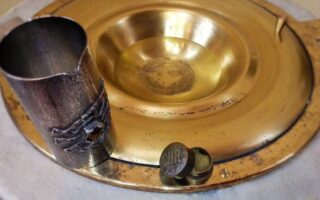The Angelus is a traditional Catholic devotion that commemorates the Incarnation of Jesus Christ. It is typically recited three times a day – at 6am, noon, and 6pm – and consists of prayers and reflections on the Annunciation and the mystery of the Word becoming flesh. The devotion is a way for Catholics to pause and reflect on the central mystery of their faith and to unite themselves with the prayers of the Church throughout the day.
Table of Contents
Origins of the Angelus Prayer
Have you ever heard of the Angelus prayer in the Catholic Church? If not, you’re in for a treat! The Angelus is a beautiful prayer that has been recited by Catholics for centuries. But where did this prayer come from, and why is it so important in the Catholic tradition?
The origins of the Angelus prayer can be traced back to the Middle Ages. It is believed to have originated in Italy in the 11th century, but it wasn’t until the 13th century that it became more widely known and practiced. The prayer itself is based on the biblical account of the Annunciation, when the angel Gabriel appeared to the Virgin Mary to announce that she would conceive and bear a son, Jesus.
The Angelus prayer is traditionally recited three times a day – at 6am, noon, and 6pm – to commemorate the events of the Annunciation and the Incarnation. The prayer consists of three Hail Marys, interspersed with short verses and responses that reflect on the mystery of the Incarnation. It is a simple yet powerful prayer that helps Catholics to pause and reflect on the presence of God in their lives.
The Angelus prayer has a rich history in the Catholic Church and has been promoted by various popes over the centuries. Pope John XXII, in particular, was a strong advocate for the Angelus prayer and encouraged Catholics to recite it daily. In more recent times, Pope John Paul II also promoted the Angelus prayer as a way to deepen one’s relationship with God and to foster a spirit of prayer and contemplation.
The Angelus prayer is not only a beautiful tradition in the Catholic Church, but it also serves as a reminder of the importance of prayer in the life of a believer. By reciting the Angelus prayer three times a day, Catholics are encouraged to pause and turn their hearts and minds to God, acknowledging His presence and seeking His guidance and grace.
In addition to its spiritual significance, the Angelus prayer also has a practical purpose. In the past, church bells would ring at the designated times for the Angelus prayer, signaling to the faithful that it was time to stop and pray. While this practice is less common today, the Angelus prayer still serves as a reminder for Catholics to take a moment out of their busy day to connect with God and offer Him their prayers and intentions.
Overall, the Angelus prayer is a beautiful and meaningful tradition in the Catholic Church that has stood the test of time. Its origins may be rooted in the Middle Ages, but its message of faith, hope, and love continues to resonate with believers today. So the next time you hear the Angelus bell ring, take a moment to pause and join in this ancient prayer that has been recited by generations of Catholics before you.
Meaning and Significance of the Angelus
Have you ever heard of the Angelus in the Catholic Church? If not, you’re in for a treat! The Angelus is a traditional Catholic devotion that has been practiced for centuries. It is a prayer that is said three times a day – in the morning, at noon, and in the evening – to commemorate the Incarnation of Jesus Christ. But what exactly is the Angelus and why is it so significant in the Catholic faith?
The Angelus is a simple yet powerful prayer that consists of three Hail Marys, interspersed with short verses and responses. The prayer begins with the ringing of a bell, which is meant to call the faithful to prayer. The first part of the prayer recalls the Annunciation, when the angel Gabriel appeared to the Virgin Mary and announced that she would conceive and bear a son, Jesus. The second part of the prayer focuses on the Incarnation, when the Word became flesh and dwelt among us. The final part of the prayer asks for Mary’s intercession and concludes with a prayer for peace.
The Angelus is a beautiful way to pause and reflect on the mystery of the Incarnation. By reciting this prayer three times a day, Catholics are reminded of the central mystery of their faith – that God became man in the person of Jesus Christ. It is a way to sanctify the day and to keep God at the center of one’s life. The Angelus is a reminder that God is always present and that we are called to respond to his love with faith and devotion.
The Angelus is also a way to honor the Virgin Mary, who played a central role in the Incarnation. By reciting this prayer, Catholics express their love and devotion to the Mother of God and seek her intercession in their lives. Mary is seen as the perfect model of faith and obedience, and by praying the Angelus, Catholics seek to imitate her virtues and draw closer to her Son, Jesus.
The Angelus is not just a prayer, but a way of life for many Catholics. It is a reminder to pause and turn to God in the midst of a busy day. By reciting this prayer, Catholics are reminded of the importance of prayer and the need to keep God at the center of their lives. The Angelus is a way to sanctify time and to make every moment a sacred moment.
In conclusion, the Angelus is a beautiful and meaningful prayer in the Catholic Church. It is a way to commemorate the mystery of the Incarnation and to honor the Virgin Mary. By reciting this prayer three times a day, Catholics are reminded of the central mystery of their faith and are called to respond with faith and devotion. The Angelus is a way to sanctify time and to keep God at the center of one’s life. So why not give it a try and incorporate the Angelus into your daily routine? You may be surprised at the peace and joy it brings to your life.
How to Pray the Angelus

Have you ever heard of the Angelus prayer in the Catholic Church? If not, you’re in for a treat! The Angelus is a beautiful prayer that has been recited by Catholics for centuries. It is a way to honor the Incarnation of Jesus Christ and to reflect on the mystery of God becoming man. In this article, we will explore what the Angelus is and how you can incorporate it into your daily prayer life.
The Angelus prayer is traditionally recited three times a day: at 6am, noon, and 6pm. The prayer consists of three Hail Marys, interspersed with short verses and responses. The prayer begins with the Angelus bell, which is rung to remind Catholics to pause and pray. The prayer itself is a beautiful meditation on the Annunciation, when the angel Gabriel appeared to the Virgin Mary and announced that she would conceive and bear a son.
To pray the Angelus, start by making the Sign of the Cross. Then, recite the Angelus prayer:
The Angel of the Lord declared unto Mary,
And she conceived of the Holy Spirit.
Hail Mary, full of grace, the Lord is with thee.
Blessed art thou among women,
and blessed is the fruit of thy womb, Jesus.
Holy Mary, Mother of God,
pray for us sinners,
now and at the hour of our death. Amen.
Behold the handmaid of the Lord,
Be it done unto me according to thy word.
Hail Mary…
And the Word was made flesh,
And dwelt among us.
Hail Mary…
Pray for us, O holy Mother of God,
That we may be made worthy of the promises of Christ.
Let us pray:
Pour forth, we beseech Thee, O Lord, Thy grace into our hearts;
that we, to whom the Incarnation of Christ, Thy Son,
was made known by the message of an angel,
may by His Passion and Cross
be brought to the glory of His Resurrection.
Through the same Christ our Lord. Amen.
The Angelus prayer is a beautiful way to pause and reflect on the mystery of the Incarnation. It is a reminder of God’s love for us and His desire to be close to us. By praying the Angelus, we can deepen our relationship with God and grow in our faith.
If you’re looking to incorporate the Angelus into your daily prayer routine, consider setting a reminder on your phone or computer for 6am, noon, and 6pm. Take a few minutes to pause and pray the Angelus, allowing yourself to be fully present to God’s presence in your life.
In conclusion, the Angelus prayer is a beautiful tradition in the Catholic Church that can help us grow closer to God and deepen our faith. By incorporating the Angelus into your daily prayer routine, you can experience the peace and joy that comes from meditating on the mystery of the Incarnation. So why not give it a try and see how the Angelus can enrich your spiritual life?
The Angelus in Catholic Tradition
Have you ever heard of the Angelus in the Catholic Church? If not, you’re in for a treat! The Angelus is a traditional Catholic devotion that has been practiced for centuries. It is a beautiful prayer that is said three times a day – in the morning, at noon, and in the evening. The Angelus is a way for Catholics to pause and reflect on the mystery of the Incarnation, when the angel Gabriel announced to Mary that she would conceive and bear the Son of God.
The Angelus prayer consists of three Hail Marys, interspersed with short verses and responses. It is a simple yet powerful prayer that helps Catholics to focus on the central mystery of their faith – the coming of Jesus into the world. The Angelus is a reminder of the importance of prayer and contemplation in the life of a Catholic.
The Angelus has a long history in the Catholic Church. It is believed to have originated in the 11th century, when it was customary for church bells to ring at certain times of the day to call the faithful to prayer. The Angelus prayer was recited at these times as a way of sanctifying the day and keeping the faithful mindful of the presence of God in their lives.
Today, the Angelus is still recited in many Catholic churches and homes around the world. It is a cherished tradition that helps Catholics to stay connected to their faith and to each other. The Angelus is a way of uniting Catholics in prayer and reflection, no matter where they are or what they are doing.
The Angelus is a beautiful prayer that is steeped in tradition and meaning. It is a way for Catholics to honor the mystery of the Incarnation and to deepen their relationship with God. The Angelus is a reminder of the importance of prayer and contemplation in the life of a Catholic.
The Angelus is a simple yet profound prayer that can be recited by anyone, anywhere. It is a way of sanctifying the day and keeping the faithful mindful of the presence of God in their lives. The Angelus is a way of connecting with the divine and with each other, no matter where we are or what we are doing.
In conclusion, the Angelus is a cherished tradition in the Catholic Church that has been practiced for centuries. It is a beautiful prayer that helps Catholics to reflect on the mystery of the Incarnation and to deepen their relationship with God. The Angelus is a way of uniting Catholics in prayer and reflection, no matter where they are or what they are doing. So why not give it a try and see how it can enrich your spiritual life?
Variations of the Angelus Prayer
Have you ever heard of the Angelus prayer in the Catholic Church? If not, you’re in for a treat! The Angelus is a traditional Catholic devotion that has been recited by believers for centuries. It is a beautiful prayer that focuses on the Annunciation of the Angel Gabriel to the Virgin Mary, announcing the Incarnation of Jesus Christ. The prayer is typically recited three times a day – at 6am, noon, and 6pm – to commemorate the events of the Annunciation and the Incarnation.
The Angelus prayer consists of three Hail Marys, interspersed with short verses and responses. The prayer begins with the ringing of a bell, which is meant to call the faithful to prayer. The first part of the prayer focuses on the Annunciation itself, with the words “The Angel of the Lord declared unto Mary.” This is followed by the response “And she conceived of the Holy Spirit.” The second part of the prayer focuses on the Incarnation, with the words “Behold the handmaid of the Lord.” This is followed by the response “Be it done unto me according to thy word.” The prayer concludes with the recitation of the Hail Mary.
While the Angelus prayer is typically recited in this traditional form, there are also variations of the prayer that have been developed over the years. One popular variation is the Regina Caeli, which is recited during the Easter season in place of the Angelus. The Regina Caeli is a hymn of praise to the Blessed Virgin Mary, celebrating her role in the Resurrection of Jesus Christ. Another variation of the Angelus prayer is the Angelus Domini, which is recited in some religious communities as a way of honoring the Angel Gabriel.
In addition to these variations, there are also different ways of praying the Angelus depending on the time of year. For example, during the season of Advent, the Angelus prayer may be recited with special antiphons that focus on the coming of Christ. Similarly, during the season of Lent, the Angelus prayer may be recited with a focus on repentance and preparation for Easter.
Overall, the Angelus prayer is a beautiful and meaningful devotion that can help Catholics deepen their relationship with God and the Blessed Virgin Mary. Whether recited in its traditional form or in one of its variations, the Angelus prayer is a powerful way to reflect on the mysteries of the Annunciation and the Incarnation. So why not give it a try? Set a reminder on your phone for 6am, noon, and 6pm, and take a few moments to recite the Angelus prayer. You may be surprised at how this simple act of devotion can bring peace and joy to your day.
Conclusion
The Angelus is a Catholic devotion commemorating the Incarnation of Jesus Christ. It consists of three prayers recited at morning, noon, and evening. The devotion is traditionally recited in Latin, but can also be said in the vernacular. The Angelus serves as a reminder of the Annunciation and encourages believers to reflect on the mystery of the Word becoming flesh.


